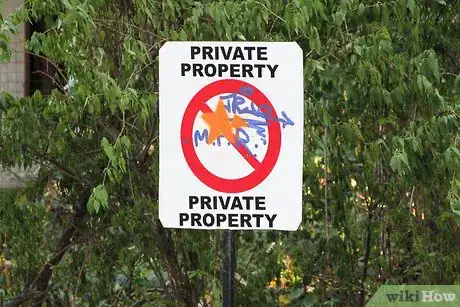wikiHow is a “wiki,” similar to Wikipedia, which means that many of our articles are co-written by multiple authors. To create this article, 69 people, some anonymous, worked to edit and improve it over time.
wikiHow marks an article as reader-approved once it receives enough positive feedback. In this case, 90% of readers who voted found the article helpful, earning it our reader-approved status.
This article has been viewed 305,296 times.
Learn more...
An abandoned structure is any man made object that is no longer in use. Structures that could fall into this definition include buildings, bridges, bunkers, tunnels, drains, mines, water towers, railroad tracks, farms, wells, or houses. Here are some easy steps to recognize, enter, and get away with when exploring abandoned structures.
Steps
-
1Avoid breaking local laws. Trespassing is illegal in many countries and jurisdictions. Private property laws vary from one place to another, and you should not assume a legal action in one area is legal in another. At many larger structures, the caretakers will grant permission to view the premises they preserve. If there are signs that say "No Trespassing", don't enter unless you have permission.[1]
-
2Be aware of your actions. Without speaking with a caretaker or owner, you could be perceived as a squatter, vandal, arsonist, or someone looking for salvage. Make your intentions clear to avoid unfounded accusations. Avoid bringing anything unnecessary such as tools to avoid trouble.Advertisement
-
3Find a site to explore. In most cases, the structures you are looking to explore caught your interest during other activities, rather than by intentional scouting. However, unmentioned structures show their neglect and can be found simply by traveling around your town or city. You can also find structure locations from people with similar interests on internet forums.[2]
-
4Walk the perimeter. What are the possible entrances (or exits, if there is a need to escape)? Windows, unlocked doors, doors that can be opened by force (note laws), rooftops, tunnels, and holes are all possible entry points into abandoned buildings.
-
5Decide when to make an entrance. Sometimes it's better to enter during the day for lighting purposes, but nighttime is usually better because you're less likely to be seen. Bring a flashlight and a friend along![3]
-
6Find the easiest way in. Do you have to hop a barbed-wire fence, or can you squeeze through an opening instead? In many cases, you'll find infiltrating a structure is much easier than it looks. Barbed-wire, high walls, and locked doors are all good deterrents, but in many cases, there is a part of the structure that is much more vulnerable.[4]
-
7Explore! Take pictures; look at old furniture, papers, machinery, or anything that catches your eye.[5]
-
8Leave the structure the same way you found it. You wouldn't want to ruin the experience for future explorers. You also don't want a police report filed if anything is destroyed or stolen.[6]
Community Q&A
-
QuestionWhat should I do if there is a squatter in the structure I am exploring?
 Community AnswerIf the squatter isn't bothering you, ignore them and don't bother them. If the squatter appears threatening or attempts to attack you, leave the area immediately.
Community AnswerIf the squatter isn't bothering you, ignore them and don't bother them. If the squatter appears threatening or attempts to attack you, leave the area immediately. -
QuestionIf the building has a fence for a door but no other fence, can I enter it?
 Community AnswerIf you can safely enter the area and it is not private property, you may enter through the fenced door.
Community AnswerIf you can safely enter the area and it is not private property, you may enter through the fenced door. -
QuestionWhat should I wear while I am exploring?
 Community AnswerWear clothes you don't mind getting dirty and thick shoes in case there is glass or other debris on the ground, jeans, sneakers or boots, and possibly a light coat or jacket should work.
Community AnswerWear clothes you don't mind getting dirty and thick shoes in case there is glass or other debris on the ground, jeans, sneakers or boots, and possibly a light coat or jacket should work.
Warnings
- If you have to "squeeze" in somewhere, consider whether you will be able to squeeze-out later.⧼thumbs_response⧽
- As said before, don't explore catacombs unless you are sure it will be fine.⧼thumbs_response⧽
- Be wary of enclosed places that can contain little to no oxygen. Pipes, pits in the ground and farm silos are all enclosed spaces that can accumulate dangerous gases.⧼thumbs_response⧽
- If an abandoned building or area has a sign that displays "NO TRESPASSING" it is illegal to enter without proper authorization.⧼thumbs_response⧽
- Don't shut any doors unless you have another way out!!!⧼thumbs_response⧽
- BE CAREFUL! Exploring any structures can be lots of fun, but it can also be very dangerous!⧼thumbs_response⧽
- Asbestos used to be a building material of choice from the 1930s up to the late 1970s. Its nano-sized particles become airborne from the slightest disturbance or draft. It is highly proven when inhaled to cause Asbestosis (scarring of the lungs), lung cancer and mesothelioma (cancer of the chest lining), which can cause a painful death. If you do not wear a gas mask, it would be well worth your time to read up and study the various forms of asbestos beforehand. This will enable you to identify asbestos and steer clear of a possible premature death.⧼thumbs_response⧽
- Taking a shower and changing clothes soon after an extended exploration is a good idea, in order to remove any irritating or harmful substances you may have accidentally come across.⧼thumbs_response⧽
- If the structure has been abandoned by the original property owner, there might be new residents (squatters!). If you find someone else inside the building, let them know you are there and tell them you're just exploring. Some squatters can be very dangerous, so try to avoid physical confrontation and leave immediately if you think you are in danger of being assaulted.⧼thumbs_response⧽
- Be careful of exploring abandoned places, you can get arrested for trespassing or other related charges.⧼thumbs_response⧽
- Be aware that actually forcing your way into a structure is an additional crime to that of trespassing.⧼thumbs_response⧽
- Spiders love old buildings, and many are poisonous. Black widow, brown recluse, and other spiders can cause serious wounds. Wear thin leather gloves for protection.⧼thumbs_response⧽
- Old buildings may contain other hazards, such as poisonous substances or asbestos. There will sometimes be a warning sign, but not always! Be careful not to disturb any insulation, ceiling, or floor tiles in order to avoid dangerous airborne asbestos fibers.⧼thumbs_response⧽
- The majority of explorers forget to ensure whether or not power is still running in a structure like a mall. If it is (or a small part is still running on generator power), be extremely cautious regarding security cameras and/or alarm systems. Some alarm systems are triggered by doors being opened, pressure plates, electromagnetic frequencies, ultraviolet, etc. and can take anywhere from a millisecond from 90 seconds to sound and alert the authorities, or if it is a silent alarm, you will be in for a surprise.⧼thumbs_response⧽
- Remember, this is illegal almost everywhere! Be careful!⧼thumbs_response⧽
- Don't forget, this can be very dangerous!⧼thumbs_response⧽
- If you must enter a building with a posted warning that it is unsafe or condemned, test every step before you put your weight down, as the floorboards may give way. Beware of peeling lead-based paint and insulation.⧼thumbs_response⧽
- Be aware that stagnant environments often lead to heightened concentrations of diseases, bugs, and pathogens. Evidence of unhealthy environments include mold, animal and bird droppings, saturated building materials, and dead animals. Areas of extreme stagnation, such as mines, pits, and drains can pose undetectable gas hazards.⧼thumbs_response⧽
- Buildings that are condemned or abandoned and boarded or fenced off are that way because they are dangerous. If you want to undertake this activity, make sure you are okay with the fact that if something goes wrong you WILL be putting your rescuers, i.e., Police, Firefighters, EMS personnel at risk when they come to your aid. Not only could you be injured and charged with a crime, but you could also get others hurt and be liable for reimbursing agencies for the expenses incurred in aiding you. Have fun if you think the risk is worth it.⧼thumbs_response⧽
- If you are confronted by a neighbor, security guard or police officer don't run away. This will only compound any trouble you may be in. Explain why you are there and what you have been doing.⧼thumbs_response⧽
- Be cautious if the structure shows signs of vandalism, forced entry, looting, or other destructive criminal acts. Urban exploring is not a destructive activity, but you can easily be blamed for any damage to a building. Consider what would happen if they charged you with whatever graffiti, theft, or property damage the building has suffered in the last few months.⧼thumbs_response⧽
- Know the local trespassing laws and be ready to accept the possible consequences. Also, be aware of mitigating circumstances: bringing a few tools in case you need them might seem like a good idea, but if you are caught, you'll be in more trouble! Also, in some areas it is a worse crime if you are caught at night.⧼thumbs_response⧽
Things You'll Need
- A pair of long pants
- A shirt with long sleeves
- A pair of gloves: thin leather is best
- Sturdy footwear - waterproof is best
- A flashlight (Red Filter Optional)
- A spare flashlight
- A camera (recommended - if you are caught, it will help to have some physical evidence that you were there doing something other than stealing or vandalizing)
- Spare batteries
- A map of the area (if available)
- Gas mask/Goggles & respirator for eye and lung protection (Not all respirators are certified to protect you from asbestos. Make sure you know what kind you are buying)
- A Trusted Buddy for Backup (dangerous situations)
- Do not bring any tools such as screwdrivers, wrenches, wire-strippers, etc. - if you are caught, they will be enough to get you in trouble for attempted robbery.
- A cell phone in case you get injured.
References
- ↑ https://www.signs.com/blog/state-by-state-guide-to-no-trespassing-laws-signage/
- ↑ https://medium.com/@caseybotticello/an-introduction-to-urban-exploration-urbex-f2e0b383bbff
- ↑ https://www.youtube.com/watch?v=XsakTbEFzWY&t=1859s
- ↑ https://www.huffpost.com/entry/the-5-rules-you-need-to-k_b_14656484
- ↑ https://expertphotography.com/urban-exploration-photography-tips/
- ↑ https://www.huffpost.com/entry/the-5-rules-you-need-to-k_b_14656484




































































